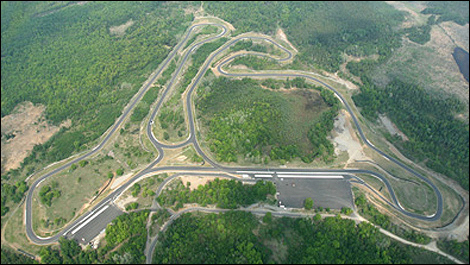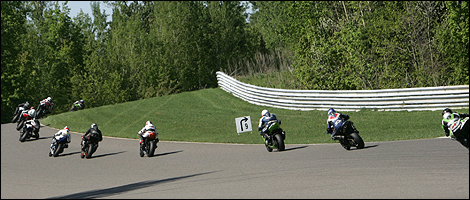I obtained my car racing licence at the last event held at the short St. Eugene track, near Rigaud on the Quebec-Ontario border, in May 1964, three months before the short Mt-Tremblant course opened in August of the same year. From then to today, I must have driven (Ridden) car or bikes on 25 tracks across America, England, France and South Africa.
 |
| Several track configurations increase the usability of the site. We ran the full course, taking full advantage of this great layout. No doubt about it, this place is a world class track facility, located in beautiful countryside. |
So when I got to Calabogie (Just North of Ottawa) for my first ARC-Turn2 Sportbike School day in September 2009, I did not expect to have to work too hard to learn the track – jeez, it’s just another a strip of pavement! How wrong I was, as four 20-min sessions and 35 odd laps later, I knew roughly which way the track went but was nowhere close to figuring out the line or having established any useful braking reference points.
Calabogie – More than meets the eye
The three-hour ride home afforded me some time to debrief myself, and I was still stumped for another several hours. Then the tricks used by track designer Alan Wilson to complicate quick riding there came to me.
Firstly, Calabogie corners come in pairs or even threesomes, combined in a way that forces you to always position yourself for the most important corner, usually but not always the last one in the string. Wilson made sure the lines were complicated by varying corner speeds and direction, to always lure the unwary onto a seemingly better but ultimately slower line. Learning proper lines through four or five clusters of corners over the 5.5km track will take time, I assure you.
The second trick our boy Wilson resorted to was to use the natural up-and-down lay of the land to create corners that drop off and disappear at the end of most straightaways, a little like “Links” golf courses. This means that you cannot see the actual braking or turn-in points when approaching most corners at high speed – you only see the braking point at the last moment before having to apply the brakes hard! It also means that wusses like me chicken out and brake early. Funny how as racers, we have taught ourselves to turn into a corner without having spotted the apex (Think corners 2, 3 and 4 at Mosport, or 7 and Namerow at Tremblant), but holding the throttle wide open past a certain point and braking blind is much more difficult, at least for me.
 |
| And off we go into the wood... These undulations are a great source of complexity when learning the track, and of satisfaction when we finally get the lines right. |

